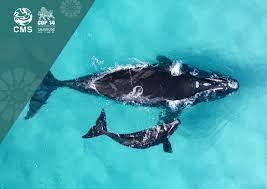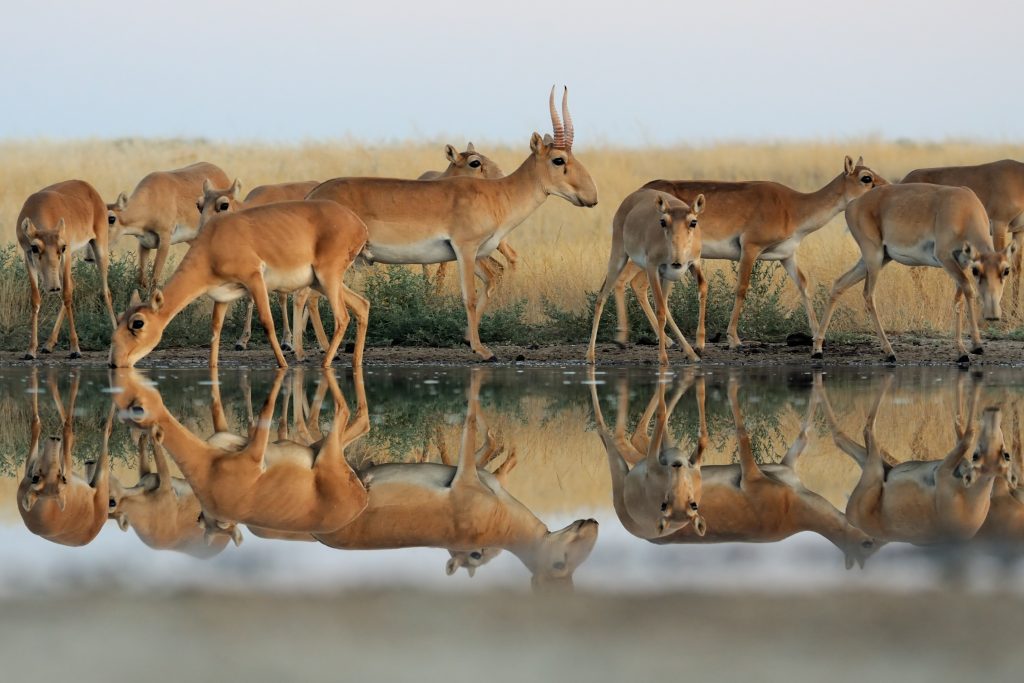
https://www.unep-wcmc.org/en/news/landmark-un-report-reveals-shocking-de...
The landmark report reveals:
- While some migratory species listed under CMS are improving, nearly half (44 per cent) are showing population declines.
- More than one-in-five (22 per cent) of CMS-listed species are threatened with extinction.
- Nearly all (97 per cent) of CMS-listed fish are threatened with extinction.
- The extinction risk is growing for migratory species globally, including those not listed under CMS.
- Half (51 per cent) of Key Biodiversity Areas identified as important for CMS-listed migratory animals do not have protected status, and 58 per cent of the monitored sites recognised as being important for CMS-listed species are experiencing unsustainable levels of human-caused pressure.
- The two greatest threats to both CMS-listed and all migratory species are overexploitation and habitat loss due to human activity. Three out of four CMS-listed species are impacted by habitat loss, degradation and fragmentation, and seven out of 10 CMS-listed species are impacted by overexploitation (including intentional taking as well as incidental capture).
- Climate change, pollution and invasive species are also having profound impacts on migratory species.
- Globally, 399 migratory species that are threatened or near threatened with extinction are not currently listed under CMS.
Until now, no such comprehensive assessment on migratory species has been carried out. The report provides a global overview of the conservation status and population trends of migratory animals, combined with the latest information on their main threats and successful actions to save them.
Today’s report clearly shows us that unsustainable human activities are jeopardising the future of migratory species – creatures who not only act as indicators of environmental change but play an integral role in maintaining the function and resilience of our planet’s complex ecosystems. The global community has an opportunity to translate this latest science of the pressures facing migratory species into concrete conservation action. Given the precarious situation of many of these animals, we cannot afford to delay, and must work together to make the recommendations a reality.
Inger Andersen, UN Environment Programme Executive Director
Billions of animals make migratory journeys each year on land, in rivers and oceans and in the skies, crossing national boundaries and continents, with some travelling thousands of miles across the globe to feed and breed.
Migratory species play an essential role in maintaining the world’s ecosystems, and provide vital benefits, by pollinating plants, transporting key nutrients, preying on pests, and helping to store carbon.

Prepared for CMS by conservation scientists at UNEP-WCMC, the CMS State of the World’s Migratory Species report uses the world's most robust species data sets and features expert contributions from institutions including BirdLife International, the International Union for Conservation of Nature and the Zoological Society of London.
The main focus of the report is the 1,189 animal species that have been recognised by CMS Parties as needing international protection and are listed under CMS, though it also features analysis linked to over 3,000 additional non-CMS migratory species.
Species listed under the Convention are those at risk of extinction across all or much of their range, or in need of coordinated international action to boost their conservation status.
Migratory species rely on a variety of specific habitats at different times in their lifecycles. They regularly travel, sometimes thousands of miles, to reach these places. They face enormous challenges and threats along the way, as well at their destinations where they breed or feed. When species cross national borders, their survival depends on the efforts of all countries in which they are found. This landmark report will help underpin much-needed policy actions to ensure that migratory species continue to thrive around the world.
Amy Fraenkel, CMS Executive Secretary
While there have been positive trends for numerous CMS species, the report’s findings underscore the need for greater action, for all migratory species. The listing of species under CMS means that these species require international cooperation to address their conservation. But many of the threats facing these species are global drivers of environmental change – affecting biodiversity loss as well as climate change. Thus, addressing the decline of migratory species requires action across governments, the private sector and other actors.
Over the past 30 years, 70 CMS-listed migratory species – including the steppe eagle, Egyptian vulture and the wild camel – have become more endangered. This contrasts with just 14 listed species that now have an improved conservation status – these include blue and humpback whales, the white-tailed sea eagle and the black-faced spoonbill.
Most worryingly, nearly all CMS-listed species of fish – including migratory sharks, rays and sturgeons – are facing a high risk of extinction, with their populations declining by 90 per cent since the 1970s.

Analysing the threats to species, the report shows the huge extent to which the decline in migratory species is being caused by human activities.
The two greatest threats to both CMS-listed and all migratory species were confirmed as overexploitation – which includes unsustainable hunting, overfishing and the capture of non-target animals such as in fisheries – and habitat loss, degradation and fragmentation – from activities such as agriculture and the expansion of transport and energy infrastructure.
One key priority is to map and take adequate steps to protect the vital locations that serve as breeding, feeding and stopover sites for migratory species. The report shows that nearly 10,000 of the world’s Key Biodiversity Areas are important for CMS-listed migratory species, but that more than half (by area) are not designated as protected or conserved areas. Fifty-eight per cent of monitored sites important for CMS-listed species are under threat due to human activities.
The report also investigated how many migratory species are at-risk but not covered by the Convention. It found 399 migratory species – mainly birds and fish, including many albatrosses and perching birds, ground sharks and stingrays – are categorised as threatened or near-threatened but are not yet CMS-listed.

While underscoring the concerning situation of many species, the report also shows that population and species-wide recoveries are possible and highlights instances of successful policy change and positive action, from local to international. Examples include coordinated local action that has seen illegal bird netting reduced by 91 per cent in Cyprus, and hugely successful integrated conservation and restoration work in Kazakhstan, which has brought the Saiga antelope back from the brink of extinction.
The State of the World’s Migratory Species report issues a clear wake-up call, and provides a set of priority recommendations for action, which include:
- Strengthen and expand efforts to tackle illegal and unsustainable taking of migratory species, as well as incidental capture of non-target species
- Increase actions to identify, protect, connect and effectively manage important sites for migratory species
- Urgently address those species in most danger of extinction, including nearly all CMS-listed fish species
- Scale up efforts to tackle climate change, as well as light, noise, chemical and plastic pollution, and,
- Consider expanding CMS listings to include more at-risk migratory species in need of national and international attention.
The UN wildlife conservation conference (CMS COP14) starting today in Samarkand, Uzbekistan is one of the most significant global biodiversity gatherings since the adoption of the Kunming-Montreal Global Biodiversity Framework (also known as “The Biodiversity Plan”). It will also be the first COP of any global environmental treaty to take place in Central Asia, a region home to many migratory species including the saiga antelope, the snow leopard, and many species of migratory birds. Governments, wildlife organisations and scientists have come together at the week-long meeting to consider actions to advance implementation of the Convention.
The State of the World’s Migratory Species report will provide the scientific grounding along with policy recommendations to set the context and provide valuable information to support the deliberations of the meeting.
Main image: A mother and calf southern right whale in the shallow waters of Cape Naturaliste, western Australia, Southern right whales migrate between their Antarctic feeding grounds and warm calving grounds closer to the equator. (Credit: Lewis Burnett / Ocean Image Bank)









